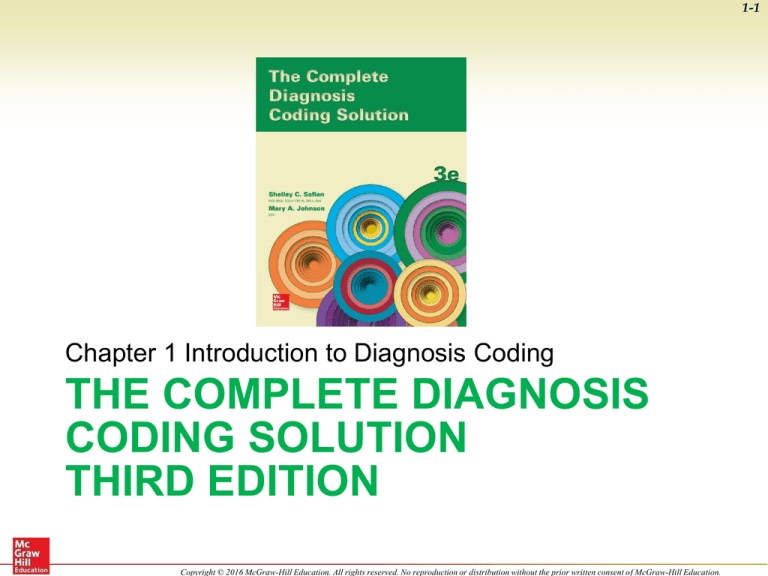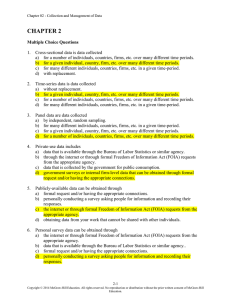
1-1
Chapter 1 Introduction to Diagnosis Coding
THE COMPLETE DIAGNOSIS
CODING SOLUTION
THIRD EDITION
Copyright © 2016 McGraw-Hill Education. All rights reserved. No reproduction or distribution without the prior written consent of McGraw-Hill Education.
1-2
Learning Outcomes
1.1 Explain the purpose of health care
coding.
1.2 Apply correctly the appropriate steps
to coding.
1.3 Apply the official guidelines provided
to find the best, most accurate code.
Copyright © 2016 McGraw-Hill Education. All rights reserved. No reproduction or distribution without the prior written consent of McGraw-Hill Education.
1-3
Learning Outcomes (cont.)
1.4 Detect the ethical danger zones
that might exist in the workplace.
1.5 Know the AHIMA Code of Ethics
and AHIMA’s Standards of Ethical
Coding.
1.6 Know the AAPC Code of Ethics.
Copyright © 2016 McGraw-Hill Education. All rights reserved. No reproduction or distribution without the prior written consent of McGraw-Hill Education.
1-4
Key Terms
• Adverse effect
• Anatomical cavity
• Anatomical direction
• Anatomical position
• Anatomical site
• Body area
Copyright © 2016 McGraw-Hill Education. All rights reserved. No reproduction or distribution without the prior written consent of McGraw-Hill Education.
1-5
Key Terms (cont.)
• Coding for coverage
• Diagnosis
• Double billing
• Etiology
• ICD-9-CM
• ICD-10-CM
Copyright © 2016 McGraw-Hill Education. All rights reserved. No reproduction or distribution without the prior written consent of McGraw-Hill Education.
1-6
Key Terms (cont.)
• Medical Necessity
• Organ system
• Pathology
• Pathophysiology
• Pharmaceuticals
• Risk Factor
Copyright © 2016 McGraw-Hill Education. All rights reserved. No reproduction or distribution without the prior written consent of McGraw-Hill Education.
1-7
Key Terms (cont.)
• Sign
• Supporting documentation
• Symptom
• Unbundling
• Upcoding
Copyright © 2016 McGraw-Hill Education. All rights reserved. No reproduction or distribution without the prior written consent of McGraw-Hill Education.
1-8
Introduction
• The purpose of coding is to make every
effort to ensure clear and concise
communication between all parties
involved with the health and well-being of
the population.
Learning Outcome: 1.1
Copyright © 2016 McGraw-Hill Education. All rights reserved. No reproduction or distribution without the prior written consent of McGraw-Hill Education.
1-9
Introduction (cont.)
• Diagnosis is a physician’s determination
of a patient’s condition, illness, or injury.
• WHY the patient came to see the health
care provider is translated into diagnosis
codes.
Learning Outcome: 1.1
Copyright © 2016 McGraw-Hill Education. All rights reserved. No reproduction or distribution without the prior written consent of McGraw-Hill Education.
1-10
Introduction (cont.)
• A SIGN is objective evidence of a
disease or condition.
– Example: Fever
• A SYMPTOM is subjective, as related
by the patient.
– Example: Feeling tired
Learning Outcome: 1.1
Copyright © 2016 McGraw-Hill Education. All rights reserved. No reproduction or distribution without the prior written consent of McGraw-Hill Education.
1-11
Introduction (cont.)
• Signs and symptoms are only coded
when there is no definite diagnosis.
Learning Outcome: 1.3
Copyright © 2016 McGraw-Hill Education. All rights reserved. No reproduction or distribution without the prior written consent of McGraw-Hill Education.
1-12
Medical Necessity
• Diagnosis codes explain WHY the
insurance carrier should pay for the
provision of procedures, treatments,
and services.
• Medical necessity identifies that the
physician was acting within the bounds
of good medicine.
Learning Outcome: 1.1
Copyright © 2016 McGraw-Hill Education. All rights reserved. No reproduction or distribution without the prior written consent of McGraw-Hill Education.
1-13
Medical Necessity (cont.)
• Procedure codes explain WHAT the
health care professional did for the patient
during this encounter.
• Procedure codes are reported from CPT
and ICD-10-PCS.
Learning Outcome: 1.2
Copyright © 2016 McGraw-Hill Education. All rights reserved. No reproduction or distribution without the prior written consent of McGraw-Hill Education.
1-14
Steps to Accurate Coding
• Read the notes and superbill completely.
• Highlight key words regarding the
diagnoses (WHY) and the procedures
(WHAT) occurred during this encounter.
Learning Outcome: 1.2
Copyright © 2016 McGraw-Hill Education. All rights reserved. No reproduction or distribution without the prior written consent of McGraw-Hill Education.
1-15
Steps to Accurate Coding (cont.)
• Query the physician if there is any
unclear, conflicting, or missing
information.
• Code each diagnosis and/or appropriate
signs or symptoms.
Learning Outcome: 1.2
Copyright © 2016 McGraw-Hill Education. All rights reserved. No reproduction or distribution without the prior written consent of McGraw-Hill Education.
1-16
Steps to Accurate Coding (cont.)
• Assign codes to the greatest specificity.
• Code only those documented conditions
that require or influence treatment at this
encounter.
Learning Outcome: 1.3
Copyright © 2016 McGraw-Hill Education. All rights reserved. No reproduction or distribution without the prior written consent of McGraw-Hill Education.
1-17
Steps to Accurate Coding (cont.)
• Use as many codes as are necessary to
tell the whole story of this encounter.
• Code each procedure, service, and/or
treatment provided to the patient during
this encounter.
Learning Outcome: 1.2
Copyright © 2016 McGraw-Hill Education. All rights reserved. No reproduction or distribution without the prior written consent of McGraw-Hill Education.
1-18
Steps to Accurate Coding (cont.)
• Link each and every procedure code
to at least one diagnosis code.
• Double-check your codes!
Learning Outcome: 1.2
Copyright © 2016 McGraw-Hill Education. All rights reserved. No reproduction or distribution without the prior written consent of McGraw-Hill Education.
1-19
Superbills vs. Notes
• Coding from superbills is faster but often
is NOT more ACCURATE.
• The Official Guidelines state that the
entire record should be reviewed.
Learning Outcome: 1.3
Copyright © 2016 McGraw-Hill Education. All rights reserved. No reproduction or distribution without the prior written consent of McGraw-Hill Education.
1-20
Official Guidelines
• Official Guidelines can be found in your
ICD-10-CM book for quick reference
and reminders.
• Guidelines instruct you how to code
accurately.
Learning Outcome: 1.3
Copyright © 2016 McGraw-Hill Education. All rights reserved. No reproduction or distribution without the prior written consent of McGraw-Hill Education.
1-21
Ethical & Legal Coding
• Don’t report a code without the
supporting documentation.
• Coding for coverage is illegal.
• It is fraud to upcode (use a code that
claims a higher level of service or a more
severe condition than is true).
Learning Outcome: 1.4
Copyright © 2016 McGraw-Hill Education. All rights reserved. No reproduction or distribution without the prior written consent of McGraw-Hill Education.
1-22
Ethical & Legal Coding (cont.)
• It is illegal to unbundle combination
codes.
• You must code ALL conditions relevant
to the current encounter.
• Codes for one encounter must be shown
on one claim form.
Learning Outcome: 1.4
Copyright © 2016 McGraw-Hill Education. All rights reserved. No reproduction or distribution without the prior written consent of McGraw-Hill Education.
1-23
Ethical & Legal Coding (cont.)
• It is not worth breaking the law, and
chancing getting hit with fines, penalties,
and possibly prison, just to hang on to a
job.
Learning Outcome: 1.4
Copyright © 2016 McGraw-Hill Education. All rights reserved. No reproduction or distribution without the prior written consent of McGraw-Hill Education.
1-24
Resources
• Medical dictionary
• Merck Manual
• Physician’s Desk Reference (PDR)
• Coding Clinic
• Correct Coding Initiative
Learning Outcome: 1.2
Copyright © 2016 McGraw-Hill Education. All rights reserved. No reproduction or distribution without the prior written consent of McGraw-Hill Education.
1-25
Organ Systems
• Integumentary system
• Musculoskeletal system
• Respiratory system
• Cardiovascular system
• Digestive system
• Urinary system
Learning Outcome: 1.6
Copyright © 2016 McGraw-Hill Education. All rights reserved. No reproduction or distribution without the prior written consent of McGraw-Hill Education.
1-26
Organ Systems (cont.)
• Genital system
• Nervous system
• Sensory systems
• Endocrine system
• Lymphatic system
• Hematologic system
Learning Outcome: 1.6
Copyright © 2016 McGraw-Hill Education. All rights reserved. No reproduction or distribution without the prior written consent of McGraw-Hill Education.
1-27
Body Areas
• Head, eyes, ears, nose, and throat Neck
• Torso
• Breasts
• Skin
• Abdomen
Learning Outcome: 1.6
Copyright © 2016 McGraw-Hill Education. All rights reserved. No reproduction or distribution without the prior written consent of McGraw-Hill Education.
1-28
Body Areas (cont.)
• Groin
• Buttocks
• Arm(s)
• Leg(s)
• Feet
Learning Outcome: 1.6
Copyright © 2016 McGraw-Hill Education. All rights reserved. No reproduction or distribution without the prior written consent of McGraw-Hill Education.
1-29
Anatomical Positions
Learning Outcome: 1.6
Copyright © 2016 McGraw-Hill Education. All rights reserved. No reproduction or distribution without the prior written consent of McGraw-Hill Education.
1-30
Body Planes
Learning Outcome: 1.6
Copyright © 2016 McGraw-Hill Education. All rights reserved. No reproduction or distribution without the prior written consent of McGraw-Hill Education.
1-31
Anatomical Directions
Copyright © 2016 McGraw-Hill Education. All rights reserved. No reproduction or distribution without the prior written consent of McGraw-Hill Education.
1-32
Anatomical Directions
• Top to Bottom
– Superior
– Cephalad
– Inferior
– Caudal
– Palmar
– Plantar
Learning Outcome: 1.6
Copyright © 2016 McGraw-Hill Education. All rights reserved. No reproduction or distribution without the prior written consent of McGraw-Hill Education.
1-33
Anatomical Directions (cont.)
• Side and Side
– Left
– Right
– Lateral
– Bilateral
Learning Outcome: 1.6
Copyright © 2016 McGraw-Hill Education. All rights reserved. No reproduction or distribution without the prior written consent of McGraw-Hill Education.
1-34
Anatomical Directions (cont.)
• Side and Side (cont.)
– Medial
– Proximal
– Distal
– Transverse
Learning Outcome: 1.6
Copyright © 2016 McGraw-Hill Education. All rights reserved. No reproduction or distribution without the prior written consent of McGraw-Hill Education.
1-35
Anatomical Directions (cont.)
• Front to Back
– Anterior
– Ventral
– Posterior
– Dorsal
Learning Outcome: 1.6
Copyright © 2016 McGraw-Hill Education. All rights reserved. No reproduction or distribution without the prior written consent of McGraw-Hill Education.
1-36
Anatomical Directions (cont.)
• Inside and Outside
– Visceral
– Deep
– Medullary
– Parietal
– Superficial
– Cortical
Learning Outcome: 1.6
Copyright © 2016 McGraw-Hill Education. All rights reserved. No reproduction or distribution without the prior written consent of McGraw-Hill Education.
1-37
Anatomical Directions (cont.)
• Direction for Imaging
– Anteroposterior (AP)
– Lateral (lat)
– Left anterior oblique (LAO)
– Left posterior oblique (LPO)
Learning Outcome: 1.6
Copyright © 2016 McGraw-Hill Education. All rights reserved. No reproduction or distribution without the prior written consent of McGraw-Hill Education.
1-38
Anatomical Directions (cont.)
• Direction for Imaging (cont.)
– Oblique (O)
– Posteroanterior (PA).
– Right anterior oblique (RAO)
– Right posterior oblique (RPO)
Learning Outcome: 1.6
Copyright © 2016 McGraw-Hill Education. All rights reserved. No reproduction or distribution without the prior written consent of McGraw-Hill Education.
1-39
Anatomical Cavities
Learning Outcome: 1.6
Copyright © 2016 McGraw-Hill Education. All rights reserved. No reproduction or distribution without the prior written consent of McGraw-Hill Education.
1-40
Abdominopelvic Cavity
• The Nine Regions
Learning Outcome: 1.6
Copyright © 2016 McGraw-Hill Education. All rights reserved. No reproduction or distribution without the prior written consent of McGraw-Hill Education.
1-41
Abdominopelvic Cavity (cont.)
• The Quadrants
Learning Outcome: 1.6
Copyright © 2016 McGraw-Hill Education. All rights reserved. No reproduction or distribution without the prior written consent of McGraw-Hill Education.
1-42
Codes of Ethics
• American Health Information
Management Association (AHIMA)
– Code of Ethics
– Standards of Ethical Coding
Learning Outcome: 1.5
Copyright © 2016 McGraw-Hill Education. All rights reserved. No reproduction or distribution without the prior written consent of McGraw-Hill Education.
1-43
Codes of Ethics (cont.)
• American Academy of Professional
Coders (AAPC)
– Code of Ethical Standards
Learning Outcome: 1.6
Copyright © 2016 McGraw-Hill Education. All rights reserved. No reproduction or distribution without the prior written consent of McGraw-Hill Education.
1-44
Chapter Summary
• Once you assign a diagnosis or procedure
code to a patient’s claim form, it becomes
a legal document.
• Coding is very important to the health care
industry.
Copyright © 2016 McGraw-Hill Education. All rights reserved. No reproduction or distribution without the prior written consent of McGraw-Hill Education.






